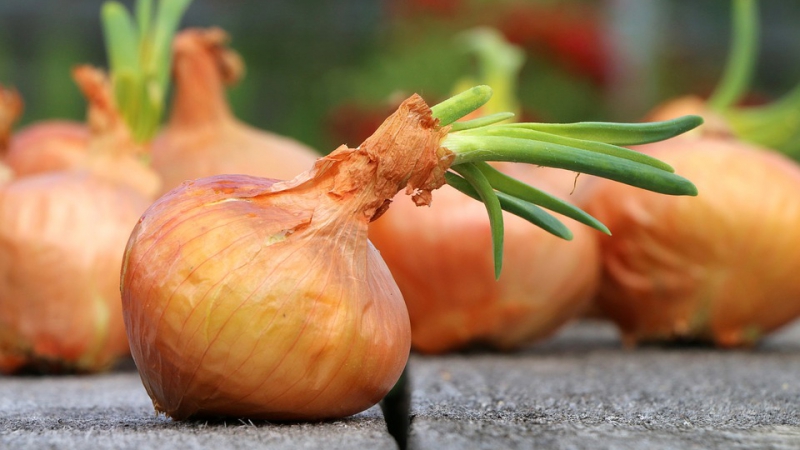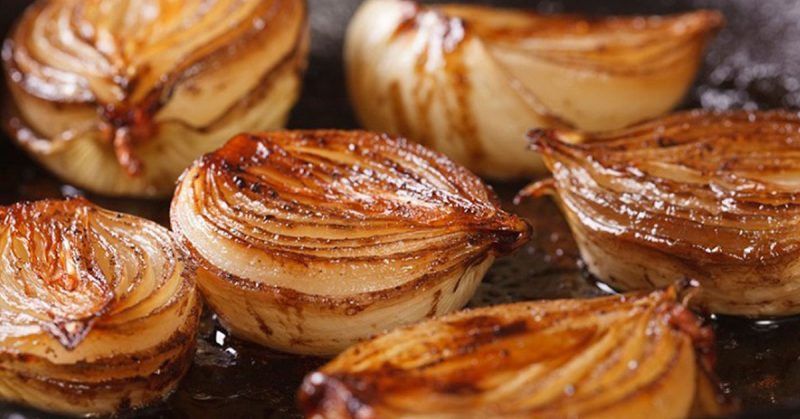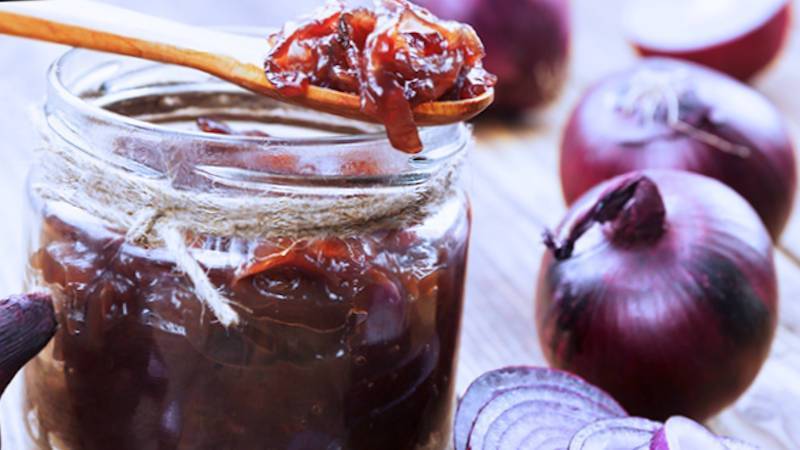Is it possible to eat onions with pancreatitis or not
It's hard to imagine a daily diet without onions. Onions, greens and leeks are consumed by themselves and are used as ingredients in various dishes. The vegetable contains essential oils and vitamins used to treat and prevent a variety of diseases.
But onions are not always useful. People who have problems with the digestive system should be especially careful: in some cases, eating onions causes serious complications.
From the article you will learn whether it is possible to eat onions with pancreatitis, how it is useful and harmful for the pancreas.
The content of the article
Chemical composition
100 g of onions contain:
- calories - 40 kcal;
- fat - 0.1 g;
- sodium - 4 mg;
- potassium - 146 mg;
- carbohydrates - 9 g;
- fiber - 1.7 g;
- sugar - 4.2 g;
- proteins - 1.1 g;
- vitamin E - 0.2 mg;
- ascorbic acid - 7.4 mg;
- vitamin B6 - 0.1 mg;
- calcium - 23 mg;
- iron - 0.2 mg;
- magnesium - 10 mg.
Onions are rich in vitamins and volatile sulfur-containing substances. Also, this vegetable contains a high concentration of vitamin C. It strengthens the immune system and is indispensable in the treatment of colds.
The bulbs contain phytoncides, known for their bactericidal action, sugars, organic acids and minerals.

Important! Scientists have discovered the flavonoid quercetin in onions. This substance accelerates the breakdown of fats, slows down the growth and division of cancer cells.
100 g of green onions contains:
- calories - 32 kcal;
- fat - 0.2 g;
- fatty acids - 1 g;
- carbohydrates - 7 g;
- fiber - 2.6 g;
- sugars - 2.3 g;
- proteins - 1.8 g;
- vitamin A - 333 mcg;
- ascorbic acid - 18.8 mg;
- vitamin B6 - 0.1 mg;
- calcium - 72 mg;
- iron - 1.5 mg;
- magnesium - 20 mg.
Green onions are rich in fiber, which improves digestion and has a beneficial effect on intestinal motility. Green feathers contain phytoncides. These substances have aseptic and antibacterial effects, which is why green onions are recommended to be consumed during colds.
Feathers also contain vitamins C, E and K, which are involved in strengthening the immune system, accelerating hair growth and improving skin condition.
Important! The most valuable is the white onion and about 10 cm of green feathers closer to it. It is there that most of all nutrients are concentrated.
100 g of leeks contain:
- calories - 61 kcal;
- fat - 0.3 g;
- fatty acids - 0.2 g;
- sodium - 20 mg;
- potassium - 180 mg;
- carbohydrates - 14 g;
- fiber - 1.8 g;
- sugar - 3.9 g;
- proteins - 1.5 g;
- vitamin A - 333 mcg;
- ascorbic acid - 12 mg;
- vitamin B6 - 0.2 mg;
- calcium - 59 mg;
- iron - 2.1 mg;
- magnesium - 28 mg.
Leek is rich in potassium salts. These substances act as a diuretic. Also, onions normalize the functioning of the liver and gallbladder, improve appetite, and prevent the formation of kidney stones.
Gastroenterologists recommend leeks for people suffering from atherosclerosis, metabolic disorders, rheumatism, gout or overwork.
Useful properties of onions
Due to the abundance of vitamins, as well as macro- and microelements, onions have a beneficial effect on the entire body:
- Its use has a beneficial effect on the digestive system.
- This vegetable has fat-burning properties, helps the body to better digest carbohydrates, thereby improving metabolism.
- Stimulates the production of insulin, digestive enzymes, improves the patency of the channels through which they enter the stomach.
- It has diuretic properties, removes excess fluid.
- Both onions and green onions contain a complex of substances that increase the level of the body's natural defenses and provide the necessary amount of vitamins, macro- and microelements.
- In the absence of contraindications, the vegetable is used to prevent colds.
- The fiber in the onion stimulates intestinal motility.
- The vegetable improves the secretion of the glands of the digestive tract.
- It has antifungal and antimicrobial effects, it is considered a natural antibiotic due to phytoncides in its composition.
The effect of onions on the pancreas in pancreatitis

Pancreatitis is an inflammation of the pancreas. Like everyone else diseases of the gastrointestinal tract, the disease imposes serious restrictions on the diet. Patients need to strictly follow the diet prescribed by the doctor to avoid deterioration of the gastrointestinal tract.
To draw up a safe menu, it is necessary to determine the form of the disease. Pancreatitis is chronic and acute. It is this factor that is key in prescribing a diet.
Acute phase
Many are interested in whether or not it is possible to eat with pancreatitis onion, green and leek. Use during an exacerbation is strictly prohibited. The reason is the high content of essential oils. They strengthen the work of the pancreas, as a result of which the organ profusely secretes a secret that corrodes its own tissues.
Fiber stimulates peristalsis, and increased digestion also increases the load on the pancreas. This leads to an aggravation of the inflammatory process.
Chronic phase
When the exacerbation of pancreatitis subsides, a period of remission begins. It happens:
- Unstable - symptoms of the disease are present, albeit in a weakened form. The use of onions is limited. This is an unstable condition, when there is a high risk of exacerbation of inflammatory processes.
- Persistent - signs completely disappear. During this period, the menu is significantly expanded. Onions are allowed to be consumed when the disease becomes chronic. Throughout it, the patient must adhere to a diet called "Table number 5".
With chronic pancreatitis, it is allowed to eat onions, but in moderation. In this case, it is imperative to monitor the state of the pancreas. If it atrophies and stops secreting enzymes, the product is excluded from the diet. Sometimes the vegetable provokes a repeated exacerbation of the disease. Then you need to give it up.
Eating onions for pancreatitis
In case of inflammation in the gastrointestinal tract, the products that the patient consumes must be heat treated. But not all methods are suitable for pancreatitis.
Doctors impose an unequivocal prohibition on fried onions: when preparing them, a large amount of oil is used, which is extremely harmful in inflammatory processes. Also, in the crust that forms on the dish, harmful substances accumulate - carcinogens, which provoke an exacerbation of the disease.
Roasting is suggested as an alternative to frying. The process does not require the use of oil in such an amount and allows you to save more nutrients.

Boiled onions are allowed to eat after the onset of remission. It is prepared as an independent dish, added to soups, sauces or gravies. During heat treatment, the amount of essential oils in the vegetable is significantly reduced. Thanks to this, its harmful effect on the pancreas is reduced.
When asked whether it is possible to eat stewed onions with pancreatitis, gastroenterologists answer in the affirmative. In case of unstable remission, it is recommended to add it to stews, soups, meat and fish dishes.
Important! Before adding onions to the menu, be sure to consult your doctor. Only a specialist, based on the patient's condition, will accurately determine whether it is safe to use it, and correctly calculate the permissible daily dose.
Start with small portions: no more than half a bulb or 2-3 green feathers. At the same time, carefully monitor your well-being, and if it worsens, stop using it.
Chives or onions may be used as an ingredient in stews, meat dishes, mashed potatoes or casseroles.
When in remission, combine onions with other types of vegetables.With a prolonged absence of signs of the disease, it is allowed to eat it even raw.
Onion recipes
Onions can be baked in the oven. For this you will need:
- 5-6 medium onions;
- 5 tbsp. l. olive oil;
- salt to taste.
Cooking process:
- The onions are cut in half and placed in a baking dish.
- After that, sprinkle them with olive oil, add a little salt and mix.
- Bake in the oven at 200 ° C until golden brown.

Leek does not have a pronounced pungent taste and strong smell, like onions or green onions, so many people prefer to use it. This product is most popular in stewed form.
To prepare stewed leek, you must:
- leek - 2 pcs.;
- garlic - 3 cloves;
- onions - 1 pc .;
- tomato paste - 200 g;
- salt to taste;
- olive oil - 1-2 tbsp. l.
Cooking process:
- Finely chop the onions or chop them with a blender.
- Put it in a greased skillet or saucepan, mix with tomato paste and simmer for a few minutes.
- Cut the leek into rings about 1 cm thick and chop the garlic.
- Add garlic with leek to the pan, salt and stir.
- Simmer the mixture for about 20 minutes under a closed lid.
This dish is served with boiled rice, meat or fish. Do not forget that spicy food for pancreatitis is prohibited, so you cannot add pepper or similar seasonings.
Important! With pancreatitis, any fried foods are prohibited, and onions are no exception. Therefore, it should not be fried, even if it is an auxiliary component of a dish, for example, a soup or a side dish.
Onions are such a versatile product that even jam is made from it. This requires only the onions themselves and sugar. For 1 kg of vegetable, you need to use 2 tbsp. Sahara.

The process of making jam is extremely simple:
- Finely chop the onion, sprinkle with sugar and stir.
- After that, cook on the stove or bake in the oven until it turns brown.
Harm and contraindications
Onions are a healthy vegetable, but unfortunately, patients with pancreatitis are not always allowed to use it.
A number of its components greatly aggravate the course of the disease:
- Essential oils. These aggressive compounds irritate the mucous membrane and stimulate the production of pancreatic juice. As a result, the pancreas suffers from the action of its own enzymes.
- Polysaccharides and complex carbohydrates. These substances are involved in the formation of fiber, the content of which in onions ranges from 1.7 to 2.6 g per 100 g. To digest fiber, the intestines are forced to work hard. Against the background of pancreatitis, this will provoke diarrhea, bloating and colic.
- Ascorbic, malic and citric acids. These substances are necessary for the body to function properly, but at the same time they increase the secretion of the pancreas.
- Onion juice adversely affects the gallbladder... Its use provokes cholecystitis.
The antibacterial properties of onions are not always beneficial. By destroying harmful microbes and bacteria, the vegetable damages the intestinal microflora.
In some cases, onions are categorically contraindicated for patients with pancreatitis:
- If the patient has an acute attack. In this case, the use of onions is immediately stopped and a doctor is consulted.
- With severe disturbances in the work of the pancreas. If the gland has atrophied and almost does not produce enzymes, it is necessary to tighten the diet by excluding the vegetable from it.
- If during remission there have already been repeated exacerbations caused by onions. This happens especially often during unstable remission or if the patient has exceeded the dosage of the product permitted by the doctor.
Read also:
Is it possible to have eggplants with pancreatitis or not.
Is it possible to eat carrots with pancreatitis and in what form.
Conclusion
Onions are a healthy vegetable, which contains many vitamins and minerals.They ensure the full functioning of the body, have a beneficial effect on all systems and organs. But for people suffering from gastrointestinal diseases, onions can cause serious harm. In chronic pancreatitis, use it with caution, and completely exclude it from the diet during an exacerbation.